| 1 | The world’s most toxic snake venom |
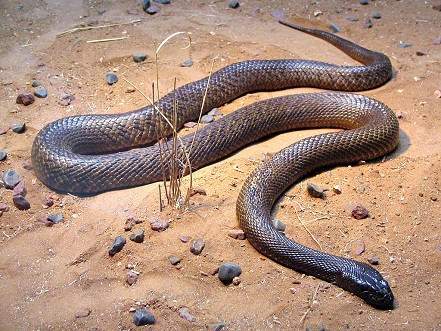
The snake with the deadliest reputation worldwide has to be the black mamba. This infamous species can raise itself off the ground with just a third of their body supporting them, and those old myths of black mambas coiling themselves into car wheels and staying put for 40 miles don’t help either. But in terms of raw venom potency, rather than people killed annually, the deadliest land-dwelling snake is actually the inland taipan of Australia.
This species belongs to the taipan genus, AKA Oxyuranus, which is relatively small, with just two other members: the coastal taipan (fairly common), and the much rarer Central Ranges taipan, which was only discovered in 2007.
The former is common in Australia’s populous east coast, but the inland taipan is somewhat of an enigma. They’re rarely encountered by Australian people except while on punishing expeditions into the heart of the scorching outback. Their main territory is southwest Queensland and south-east Northern Territory, and all the remote border areas between them. The average length for females is 2 metres, just shorter than a black mamba at 2.4 metres.
Inland taipans only bite humans if they feel seriously threatened. They’re shy animals which are hard to find, and even then only glimpsed as a quick flash of a black tail, disappearing into a dark clay crack. It’s probably lucky for humans that that’s the case…
| 2 | Why cobras can’t compare |
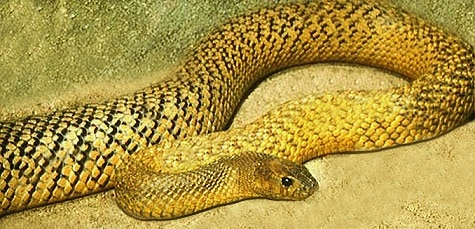
The inland taipan’s venom is a toxic soup of biological chemicals which wages war on any animal it is injected into. It’s said to be 50 times more toxic than an Indian cobra’s venom, although the cobra has the advantage when it comes to aggression.
A common factoid is that one drop of inland taipan venom is enough to kill 250,000 mice, and this originated from a closely related truth. It comes from the LD50 test devised in the 1970s. This is a simple, reliable measurement of venom potency: it measures the quantity of any substance (there’s even a figure for sugar) required to kill 50% of animals exposed to it.
The inland taipan’s LD50 was calculated at 0.025mg/kg. In comparison, a diamondback rattlesnake scores 11.4mg/kg, the black mamba scores 0.32mg/kg, and the feared king cobra scores 0.565mg/kg. The latter can kill a fully-grown elephant in a few hours.
The only saving grace for the inland taipan’s victims is that their fangs are so short. Per millilitre, it’s the most toxic venom on earth, but an inland taipan has fangs which are only 3.5mm to 6.2mm long. This is shorter than the coastal taipan and consequently, they inject only 1/3 as much venom per bite.
That said, a fully realised bite has the potential to kill 75 men, and is lethal within 30-45 minutes if untreated.
| 3 | Consists mainly of neurotoxins |
The inland taipan can strike multiple times in one attack, and it strikes with extreme precision and speed. They’re fairly easy to handle in captivity, but their venom covers every angle imaginable, with the first ingredient being potent anticoagulants. These attack fibroagulin, the main clotting protein in the bloodstream.
However, the main weapon is two separate classes of neurotoxins. The postsynaptic neurotoxins act more slowly, but cut off the signals between the brain and the wider body, leading to muscle weakness and ultimately paralysis. The pre-synaptic neurotoxins are weaker, but act more rapidly, leading to two separate waves of taipan doom. These neurotoxins respond very poorly to antivenom, whereas anticoagulants are easier to treat in a hospital bed.
Some of the specific toxins in this death juice are oxylepitoxin-1, alpha-oxytoxin 1, alpha-scutoxin 1, β-bungarotoxin and α-bungarotoxin. The venom is also loaded with mylotic enzymes which help to digest the animal’s flesh before the snake has even swallowed it.
To perfect this evil elixir, there’s enzymes called hyaluronidases, which dissolve the hyaluronic acid in your skin. Hyaluronic acid is one of the prized ingredients of modern moisturisers, but the snake’s goal is to allow extra fast absorption for its venom. Inland taipan venom isn’t notable for kidney-destroying toxins – that’s the one feature they’re missing.
| 4 | Timeline of a bite |
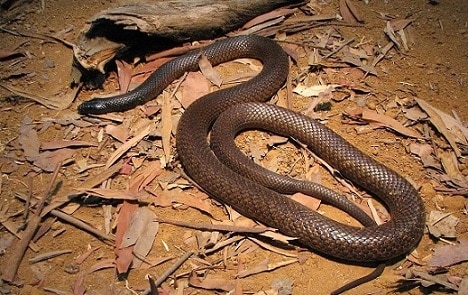
You’re walking through the Australian outback, looking for your dog which you unwisely let off the lead, when you feel a sharp pain in your leg and see a black tail vanishing into a clay crack. What happens next? The first symptoms appear after 15 minutes, and can include a headache, blurred vision, drowsiness, and slurred speech. Those are only the neurological symptoms, and the blood-related ones include vomiting blood, sudden profuse bleeding from the bite site, and a drop in blood pressure.
Things get more serious after an hour, and you may experience complete paralysis, sudden fainting, and respiratory problems that require a ventilator. If antivenom isn’t administered within the first hour, then the lack of coagulation will cause internal organs to haemorrhage blood. Death soon follows.
Those lucky enough to survive will probably remain in a critical condition for days, before the disruption of neurotransmitters finally wears off. One victim of a coastal taipan bite reported a numb leg for years afterwards; not the whole leg, but in a stripe running downwards
A less famous symptom is fixed dilated pupils. If none of these symptoms appear within 2 hours, then you’re the luckiest person in Australia and have received a dry bite. It’s said that the inland taipan has a high envenomation rate, with 90% resulting in some injection.
| 5 | But no deaths are known |
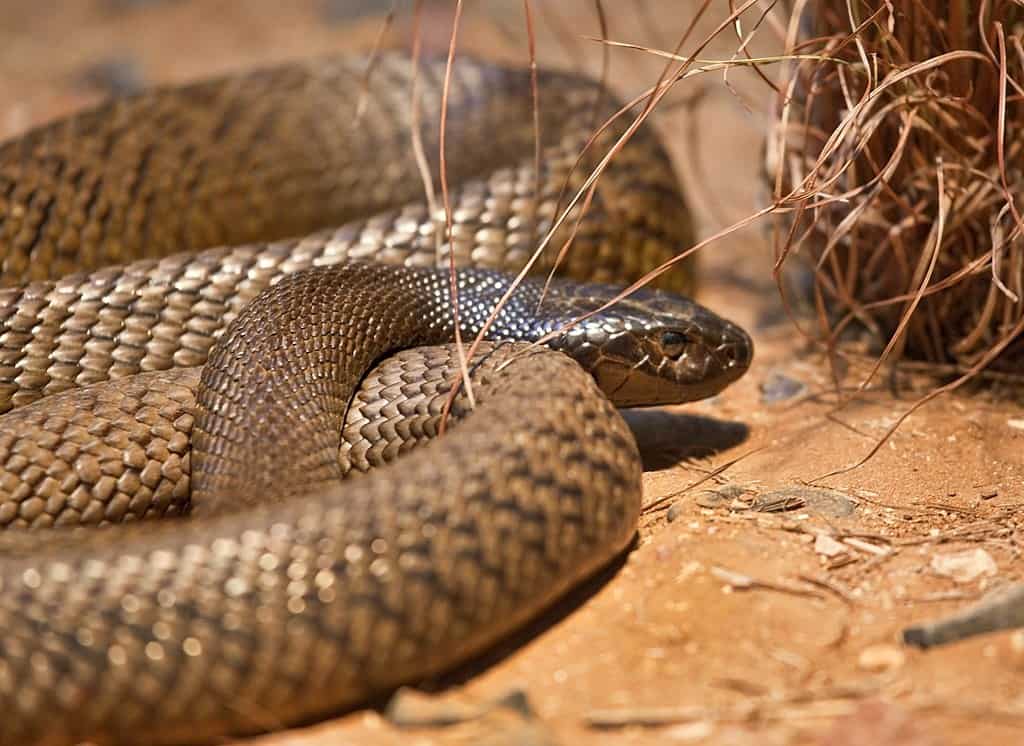
Feeling scared yet? Then don’t be, because nobody has ever died from an inland taipan bite in recorded history. It’s possible that Aborigines have fallen victim, but the most high profile case of recent times was a 17 year old boy back in 2012.
The nameless boy stumbled across an inland taipan in Kurri Kurri in the Hunter Valley region, a snake whose origins were never determined. No pet taipans were registered in the area, and speculation fell on a zoo robbery which took place on the preceding Sunday, but the police pointed out that only 4 pythons and 2 alligators were stolen.
According to reports, the boy made the mistake of trying to feed the taipan a mouse, but was bitten on the hand in a sudden strike. Both boy and snake were shipped off to Mater Hospital in Newcastle, and the doctors administered a polyvalent anti-venom as quickly as humanly possible. Crucially, this was within the 6 hour life-saving window.
Against all odds, the boy survived. The snake was 1 metre long and approximately 2 years old, and the town of Kurri Kurri was hundreds of miles from its natural habitat.
You might also be happy to hear that inland taipans have never once been spotted slithering up a toilet pipe.
| 6 | Lives in remote clay cracks |
There’s no evidence that these sinister serpents are plotting to conquer the western world either. They’re perfectly content in the dry and dusty outback, and their habitats tend to be the most deserted and roasting areas of all. Specifically, the inland taipan favours ashy soils, where deep cracks form in the cracked and barren clay. Taipans love to hide in these cracks, and mothers will commonly lay their eggs in them, usually 12 to 24. They’re also known to take shelter in mammal burrows, sometimes of the rats they’ve just killed – that’s what you call efficient.
Epic video footage has been taken of inland taipans popping their heads up from clay cracks, looking around watchfully, before dragging their entire bodies out and slithering off. The sun is merciless in this dry and inhospitable terrain; even Crocodile Dundee would tread lightly. The only vegetation is usually rows of small chenopod shrubs. It’s the kind of alien landscape a rover would take footage of, before malfunctioning during a solar storm.
Occasionally, the inland taipan will venture further afield to a rocky outcrop or a crocodile infested river, where eucalyptus trees may grow. However, they’re far from the multitaskers of boa constrictors, which appear in environments as varied as rainforests, grasslands and deserts. This fussiness is the precise reason they’ve never killed anyone.
| 7 | Diet: they love only rats |
There’s also a strong theory as to why inland taipans evolved such strong venom in the first place: the long-haired rat. This rat (rattus villosisimus) is native to the Australian outback, and has lighter than average fur. It’s fairly normal looking, but in summer, its numbers suddenly balloon to plague-like proportions, sometimes appearing in areas where it hasn’t been sighted for decades. It’s colloquially known as the plague rat, and once their numbers peak, it’s officially party time for the inland taipan.
Biologists have observed that inland taipans leave their comfy cracks in close correlation to plague rat explosions. The species forms the vast majority of their diet, alongside other small mammals such as the House Mouse (Mus musculus) and dasyurids. It’s said that inland taipans get noticeably fatter during the rat season (yes, fat snakes can exist).
The problem is that the long-haired rat is renowned for its exceptional gnawing ability. Its claws are weak, yet its teeth are vicious, and because of their naturally slow metabolisms, inland taipans can’t afford a festering wound which takes weeks to heal and runs the risk of a deadly infection. The solution is their venom, which is extremely fast-acting for a snake. The paralysing neurotoxins can render a poisoned rat immobile within minutes, after which the snake will swallow it whole.
| 8 | Usually grey, occasionally beige |
When hunting rats, the inland taipan takes full advantage of narrow cracks it dwells in, backing them into a corner. The inland taipan is an exclusively mammal-eating species, as reptiles and amphibians are too difficult for it to digest, and the same is true for coastal taipans. Despite not being inherently social, multiple inland taipans have been observed sharing the same clay cracks.
If threatened, an inland taipan will flatten its body into an s-shaped curve, and point its body directly at the threat in preparation for a strike. It’s also believed that inland taipans have above average eyesight for a snake. Don’t be knocked off course by the colour: while most inland taipans are grey, it’s possible to find beige coloured ones.
It’s commonly stated that Belcher’s sea snake actually has the most toxic venom of any snake, but apparently, this was down to an error. It was caused by different types of LD50 tests being filed incorrectly, with some testing muscle and others testing subcutaneous tissue. In reality, the belcher’s sea snake scores 0.24mg/kg, not something you’d want to ferment and turn into wine, but roughly 10 times safer than the inland taipan.
| 9 | A mystery until 1972 |
Venom isn’t the inland taipan’s only trick, as this snake fell off the map for 90 years, becoming lost to science. Dr Frederick McCoy was the man who discovered the species, near the Darling River of north-west Victoria back in 1879. A second discovery followed in Bourke, New South Wales 3 years later, and McCoy soon declared his original snake to be a whole new family: Diemenia microlepidota. Both specimens were collected, but it wasn’t until 1972 that another inland taipan was found.
Jeaneatte Covacevich was sitting at her desk one day, when she received a tin containing a mysterious snake’s head. 5 years earlier, a tour guide called Mr C had been bitten by a similarly mysterious snake, with devastating consequences, and biologists couldn’t agree on whether it was a western brown or an unidentified taipan species. Covacevich remembered this and scoured through the archives, but the only physical match for the head was a long-forgotten record from 1879. At this point, inland taipans were absent from all official guides to Australia’s snakes.
Covacevich decided to head to south-west Queensland herself. She feared that the expedition was doomed to failure, but as she drove up the dusty driveway of Herb Rabig, the man who had mailed in the tin, she noticed a piece of roadkill: a dead snake. She couldn’t believe her luck, and soon afterwards, she discovered 13 inland taipans, alive. The species was finally rediscovered, and by 1981, the inland taipan was placed in the same family as the costal taipan (Oxyuranus).
| 10 | Comparison: costal taipan |
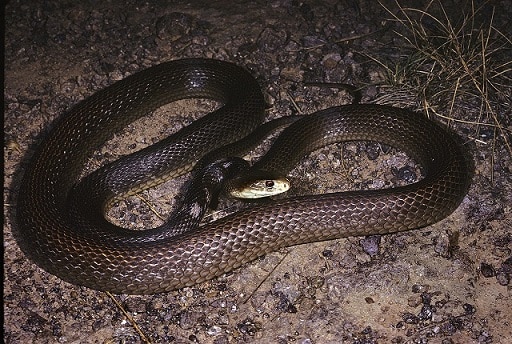
The first simple way to tell the difference is examining the head. Both species have tiny scales and a fairly consistent body colour throughout, mostly dark but with speckles of beige. There are no fantastical patterns like boa constrictors. However, the costal taipan suddenly lightens at the head, whereas the inland taipan remains consistently dark. Obviously, the best time to examine the head is as it flies towards you for a bite.
The shape of the skull is extremely similar, with the sole exception of the teeth. Costal taipans have significantly longer fangs at up to 13mm long for females, while inland taipans are 3.5-6.2mm long – not that they need fierce teeth with their radioactive venom. Inland taipans are early risers, most active at 8:00am-10:00am, whereas costal taipans are slightly lazier but still rise and get on the prowl by 9:00am. It’s the eyes that reveal all, as a coastal taipan’s are reddish, compared to very dark brown for the inland taipan.
It’s believed that the two taipans diverged 1 million years ago, which is roughly similar to the polar bear-grizzly divergence.

Very interesting, however I am happy to live in Northern Indiana. Thank You